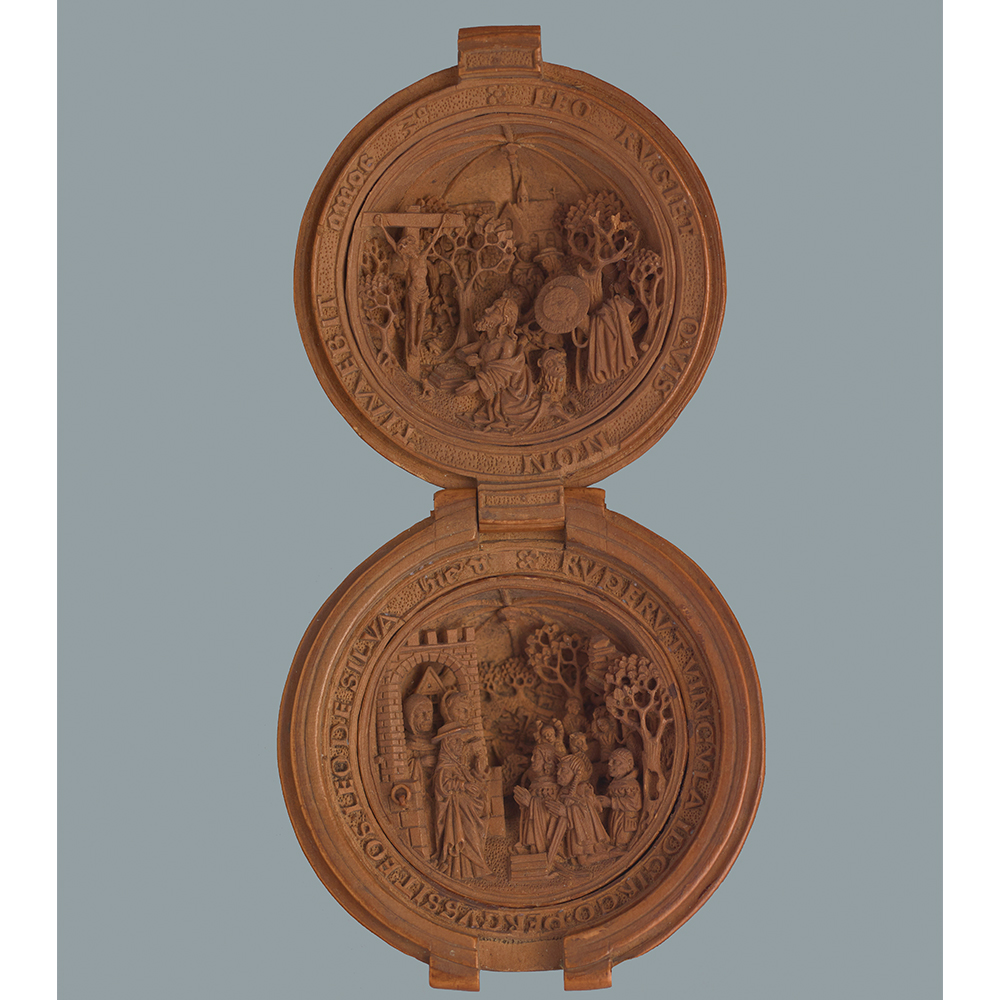Prayer Bead with Scenes from the Life of Saint Jerome

Workshop of Adam Dircksz?
c.1500–1530
Present-day Netherlands or Belgium
Boxwood
Diameter of lower hemisphere: 1.9 in (4.8 cm);
diameter of upper hemisphere: 1.7 in (4.4 cm)
Wyvern Collection, 2544
Prayer beads are designed to be held in the palm of one’s hand for private devotion. One can imagine running a thumb over the carved tracery, flipping the bead open and closed, reciting the Latin inscriptions, or admiring its mysterious interior scenes. Boxwood, a dense, finely grained hard- wood, was imported and carved in Netherlandish workshops to make prayer beads, or“nuts,” and other devotional objects. Wooden loops, seen on the exterior of this example, linked the finely carved prayer nuts to a string of smaller beads, such as a rosary or paternoster. Elaborate beads like the Wyvern example might also be worn on a woman’s belt or girdle, signaling both piety and wealth. Most prayer bead interiors reimagined familiar moments from the life of Christ, such as the Nativity or the Crucifixion, which makes this sculptural study of Saint Jerome notable.
Opening the boxwood prayer bead, one encounters two episodes from the life of Saint Jerome. A scholar and hermit, Saint Jerome is best known for preparing the Vulgate, an early Latin translation of the Bible, in the late fourth century. The Golden Legend, a collection of saints’ biographies compiled in the thirteenth century, tells how Jerome befriended a lion after courageously removing a thorn from his paw. His act of kindness and the lifelong companionship that followed is a common subject in medieval art and symbolizes the power of devotion and a fierce loyalty to the church. A Latin inscription from the Book of Amos (3:8) frames the upper interior. (1) Beneath the vaulted ceiling, in the background, Saint Jerome stands before a church facade. Next to him, a group of musicians sit in a half circle below trees behind the Crucifixion. In the middle ground, Saint Jerome, wearing a wide-brimmed hat, plays with the lion. The foreground features a larger image of Saint Jerome kneeling before Christ on the cross and beating his bare chest. He turns his back to his cardinal hat and robes, which hang idly from a tree, emphasizing his repudiation of earthly possessions for spiritual pursuits.
There is a second inscription on the lower border from the Book of Jeremiah (5:5–6). (2) Vertically aligned with the Crucifixion above, Jerome and two other men enter the scene through an archway. They greet a group of kneeling men, in a composition that parallels that of the Crucifixion scene above. Behind them, Jerome’s lion chases three men who toss their hands up in fear while the saint rides peacefully on a horse or camel in an agrarian setting. These images of Saint Jerome, in a private moment of devotion and a public reception, would have encouraged both private and public piety.
Maria McCarthy, Class of 2020
Notes
- For text and translation, see Williamson 2019, p. 335.
- For text and translation, see Williamson 2019, p. 335.